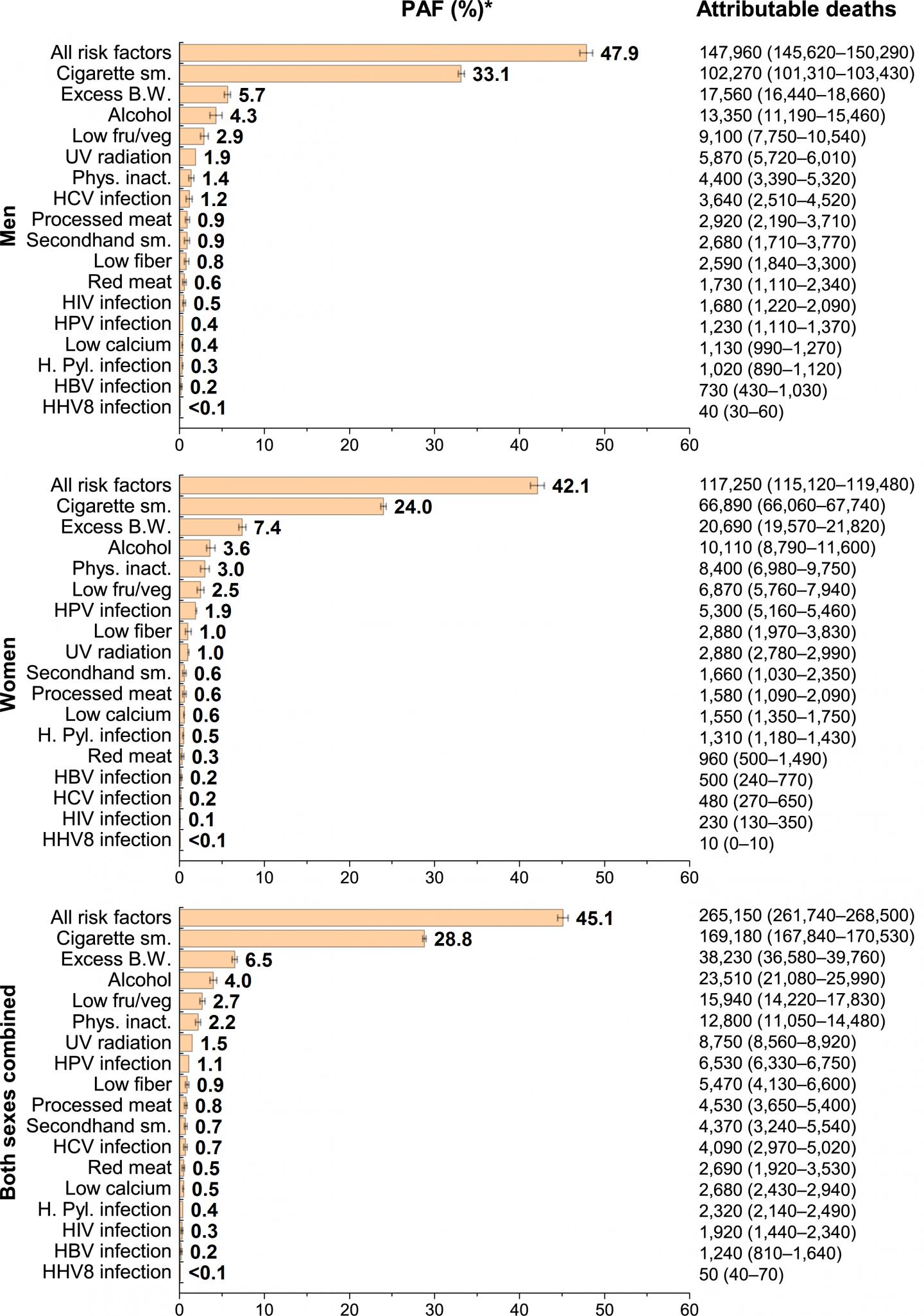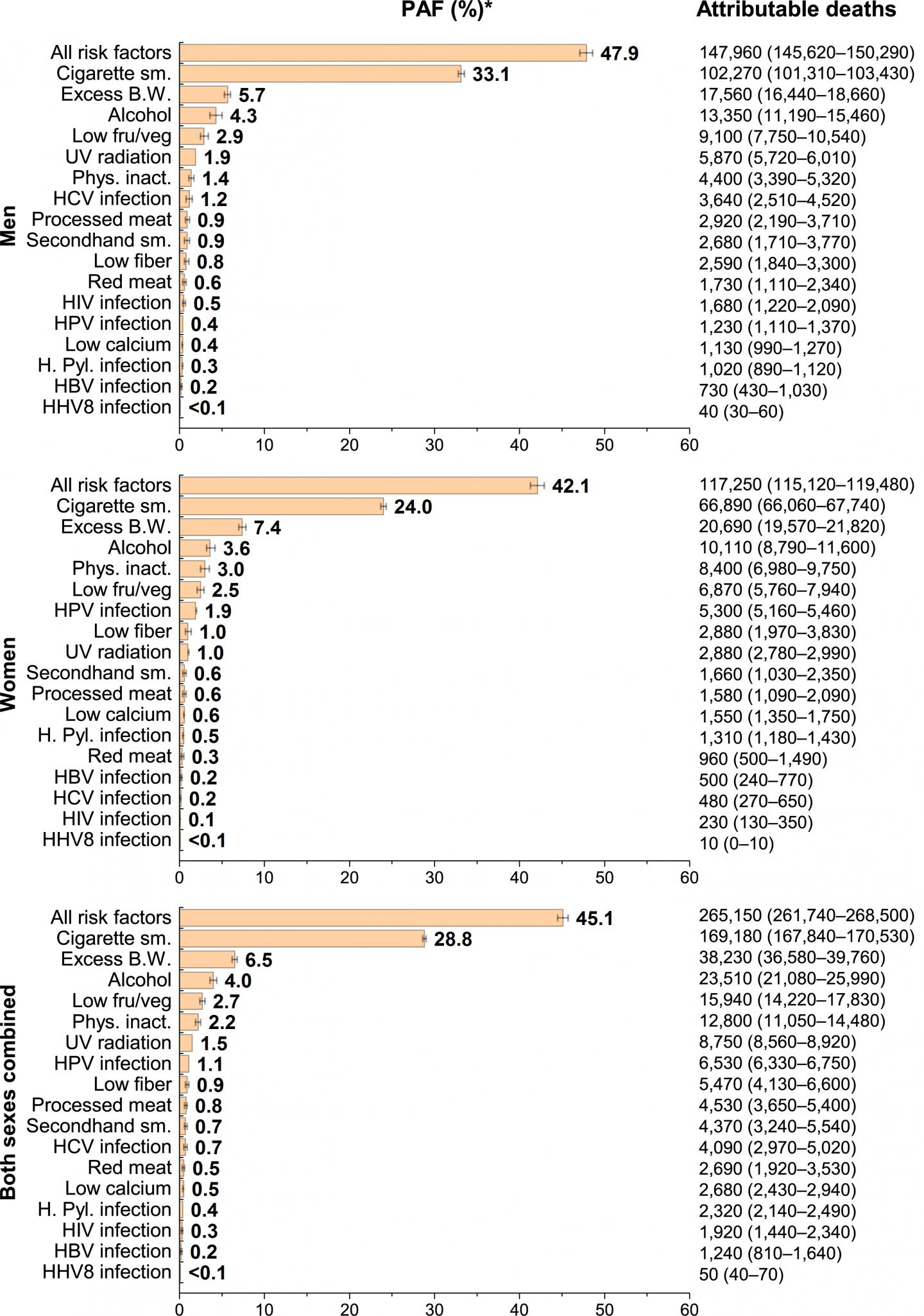
Credit: American Cancer Society
A new American Cancer Society study calculates the contribution of several modifiable risk factors to cancer occurrence, expanding and clarifying the role of known risk factors, from smoking to low consumption of fruits and vegetables. The study finds more than four in ten cancer cases and deaths in the United States are associated with these major modifiable risk factors, many of which can be mitigated with prevention strategies. The study appears early online in CA: A Cancer Journal for Clinicians.
In this new analysis, investigators led by Farhad Islami, M.D., Ph.D., of the American Cancer Society used the prevalence of known risk factors and their relative risk (the extent to which they increase cancer risk) to estimate the proportion of cancers due to those factors. They then applied those proportions to actual cancer data to estimate the number of associated cases and deaths overall and for 26 cancer types. The risk factors included in the analysis were: cigarette smoking; secondhand smoke; excess body weight; alcohol intake; consumption of red and processed meat; low consumption of fruits/vegetables, dietary fiber, and dietary calcium; physical inactivity; ultraviolet light; and six cancer-associated infections.
They found that in the U.S., an estimated 42.0% of all cancer cases (659,640 of 1,570,975 cancers) and 45.1% of cancer deaths (265,150 of 587,521 deaths) in 2014 were attributable to these modifiable risk factors.
Cigarette smoking accounted for the highest proportion of cancer cases (19.0%; 298,970 cases) and deaths (28.8%; 169,180 deaths), followed by excess body weight (7.8% of cases; 6.5% of deaths), alcohol intake (5.6% of cases; 4.0% of deaths), UV radiation (4.7% of cancers; 1.5% of deaths) and physical inactivity (2.9% of cases and 2.2% of deaths). Low fruit and vegetable intake accounted for 1.9% of cases and 2.7% of deaths, while HPV infection accounted for 1.8% of cases and 1.1% of deaths.
Lung cancer had the highest number of cancer cases (184,970) and deaths (132,960) attributable to evaluated risk factors, followed by colorectal cancer (76,910 cases and 28,290 deaths). Several major cancers had a high proportion of cases attributable to evaluated risk factors, including 85.8% of lung cancers, 71% of liver cancers, 54.6% of colorectal cancers, and 28.7% of breast cancers.
Other selected findings from the report:
- Smoking accounted for 81.7% of lung cancers, 73.8% of larynx cancers, 50% of esophageal cancers, and 46.9% of bladder cancers.
- Excess body weight was associated with 60.3% of uterine cancers, about one-third of liver cancers (33.9%), 11.3% of breast cancers in women, and 5.2% of colorectal cancers.
- Alcohol intake was associated with almost one-half of oral cavity and pharyngeal cancers in men (46.3%) and about one-fourth (27.4%) in women, 24.8% of liver cancers in men and 11.9% in women, 17.1% of colorectal cancers in men and 8.1% in women, and 16.4% of breast cancers in women.
- UV radiation was associated with 96.0% of melanomas of the skin in men and 93.7% in women.
- Physical inactivity accounted for 26.7% of uterine cancers, 16.3% of colorectal cancers, and 3.9% of female breast cancers.
- Low fruit and vegetable consumption was associated with 17.6% of oral cavity/pharyngeal cancers, 17.4% of laryngeal cancers, and 8.9% of lung cancers.
- Red and processed meat consumption accounted for 5.4% and 8.2% of colorectal cancers, respectively. Low dietary fiber accounted for 10.3% of colorectal cancer cases, while low dietary calcium accounted for 4.9% of cases.
The authors also measured the combined contribution of excess body weight, alcohol intake, poor diet, and physical inactivity to the cancer burden. These four factors accounted for 13.9% and 22.4% of all cancer cases in men and women, respectively. The corresponding proportions for cancer deaths were 14.9% and 16.9%, respectively. Studies have shown that following the American Cancer Society's cancer prevention guidelines for maintaining a healthy body weight, limiting alcohol intake (for those who drink), consuming a healthy diet, and being physically active is associated with a reduced risk of developing and dying from cancer.
The authors say their results may underestimate the overall proportion of cancers attributable to modifiable factors because several other potentially modifiable risk factors could not be evaluated due to lack of exposure data. Also, a number of cancer types with likely, but as-yet unestablished associations with modifiable risk factors were not considered.
"Our findings emphasize the continued need for widespread implementation of known preventive measures in the country to reduce the morbidity and premature mortality from cancers associated with potentially modifiable risk factors," write the authors. "Increasing access to preventive health care and awareness about preventive measures should be part of any comprehensive strategy for broad and equitable implementation of known interventions to accelerate progress against cancer."
"In 1981, Doll and Peto published what has become a classic paper on the causes of cancer," said Otis W. Brawley, M.D., American Cancer Society chief medical officer and study co-author. "Since then, volumes of data have been published that have clarified the association between several important risk factors and cancer. In this new report, ACS scientists provide a 21st century calculation that will guide us in the years ahead."
###
Article: Proportion and Number of Cancer Cases and Deaths Attributable to Potentially Modifiable Risk Factors in the United States; Farhad Islami et al. CA Can J Clin DOI 10.3322/caac.21440
URL after embargo: http://onlinelibrary.wiley.com/doi/10.3322/caac.21440/full
Media Contact
David Sampson
[email protected]
@ACSNews
http://www.cancer.org
Related Journal Article
http://dx.doi.org/10.3322/caac.21440





